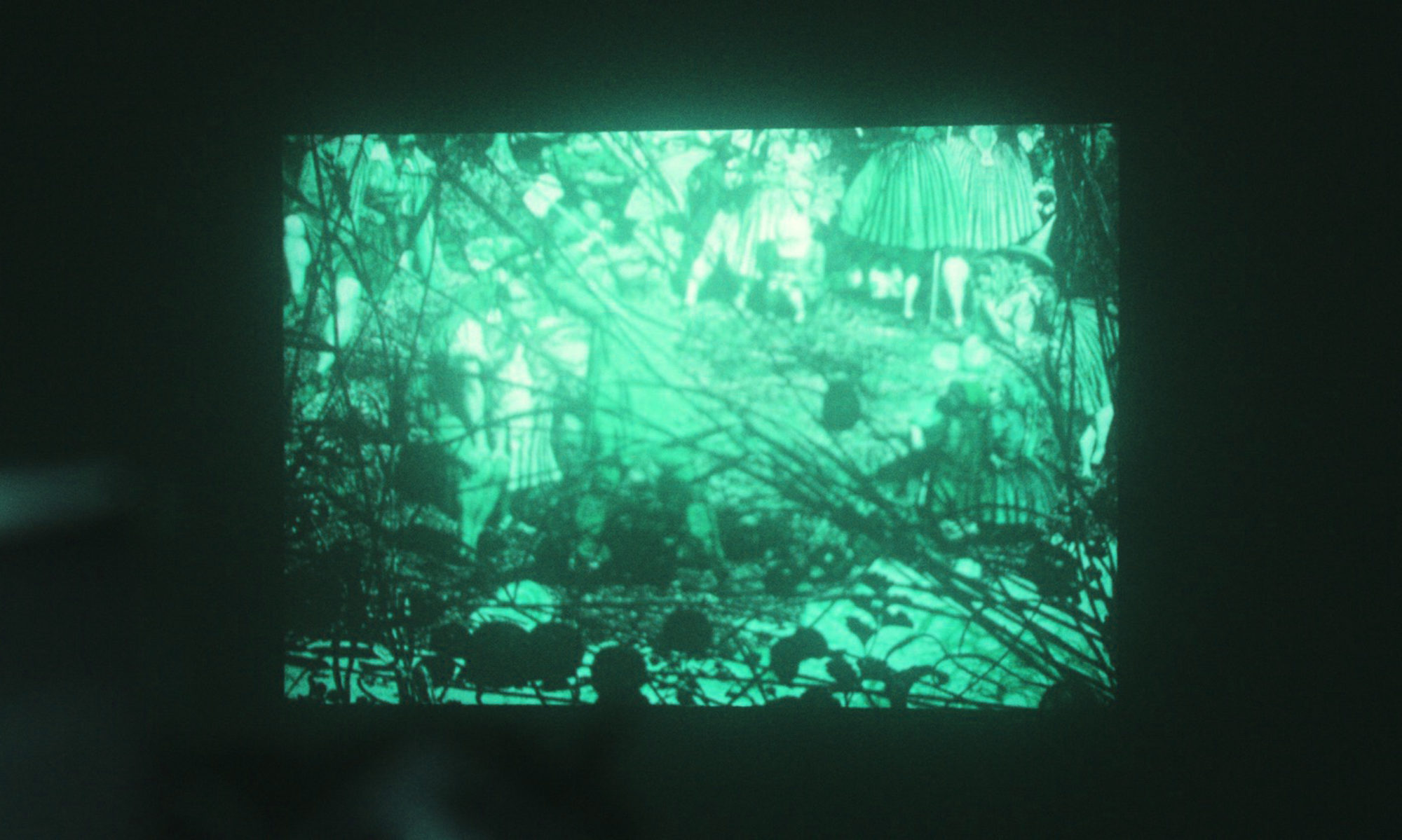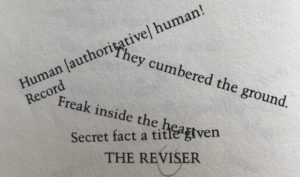And finally, from me, a few belated reflections on Dance Dance Revolution, and on the course; with the disadvantage of a growing distance from our meetings, and the advantage of the same.
First, about Dance Dance, I’ve been wondering what to make of its resemblance to a video game. Or rather, how its timeline moves from something like conventional political and social history (in Korea) into a video game version of the same. If you think about the Desert, it is set up as a series of nationally-themed hotels, each a kind of neon stereotype of itself, set in an otherwise featureless landscape; there is a bridge, and on the other side of the bridge, New City; there are two major classes of characters, guides and tourists, with an interloper historian as our avatar; some of the guides are terrorists, but we don’t know which; the landscape is sown with dangerous mines. The particular abstraction of space into discontinuous zones of interest and the schematized dramatic personae are stock-in-trade for games (or perhaps games of a slightly earlier era, when the gamescape was functionally discontinuous, requiring magical or at least adumbrated transport from zone to zone—I’m no expert, but its my sense that in the newest, you can spend as much time in the in-between as you like, and even find interest there; not so for DDR. Say, anything in that abbreviation?).
If we sense that affinity, what to make of it? Recall the double backstory for the Guide and the Historian. The Guide grew up in Kwangju, to a family of yes-men: her grandfather had collaborated with the Japanese, her father with the Americans (“He like mine grandfather yessed y yessed” [43]); she joins the resistance “to fightim me yesman lineage” (44). At the age of 20 she is the voice of the uprising against the 1980 coup, but after her capture, and a brutal imprisonment in the Ginseng Colony, she moves to the Desert; there, we learn that she fits herself into the system as best she can, even informing against jingo-purist terrorists: her yes-man lineage has apparently caught up with her. The Historian is a generation younger, born to a doctor who participated in the same uprising in 1980, but left the country afterward, to serve with Doctors Without Borders in Sierra Leone. (Her mother died when she was three.) Her father’s ethical devotion is a kind of political quiescence, and when she comes to the Desert, it is in search of a lost connection to her own family history of resistance—for we learn that her father was involved with the young Guide, before he met the Historian’s mother. The Guide, then, is makes for complicated kin: she a figure of bitter, sarcastic, self-lacerating disappointment; her polyglot linguistic virtuosity is anti-fundamentalist, perhaps, but also a versatile complicity with the Desert’s capitalist language-traffic. Her voice was her strength in Kwangju; now it is an ingenious complicity.
I offer up that much background—it is almost novelistic!—because it takes so much effort to work it all out; it is an interesting question, what kind of history you are doing, trying to assemble that narrative from the complexity of the poem. (It is not an archival labor; but it is definitely a labor.) Be that as it may, my point here is that the encounter between the two characters happens in the Desert’s video game space, a translation of history into—what, perhaps a kind of game-stasis, in which action, if that is the word, is meant to be ongoing, contained, resettable; polychronic in the manner of a theme park. The world of the poem is in stalemate between the Desert and New City, and history, of the sort that the Guide and the Historian’s father tried to make happen in Korea, is stalled, reduced to gameplay.
Except that the medium is not pixels, or polygons, but words. Language is the basis of the animosity between the Desert and New City, between the endlessly productive creole and the “jingo-purists” who have been exiled across the bridge. Here I think the poem’s politics are wonderfully thick and sophisticated. There are strong signals that the jingo-purists are to be identified with linguistic fundamentalism, perhaps Islamic fundamentalism, New City being a place “without image” (81); “They can follow their words back to the first tribe” (80) and they “crave for time to stand still” (21). We hear the story of a boy whose brother was killed by Desert officials, and who snuck back into the city as a terrorist disguised as a guide. The Desert creole is, by contrast, endlessly mutating, multicultural, and, one might expect, politically potent. And yet, at the same time, it is a kind of nightmare of reification: linguistic change there is driven by its international traffic, and by a capitalist logic that copyrights words and phrases (see the Historian’s note, 90). The jingo-purists look a little more sympathetic if we see how readily the creole accommodates itself to the state violence that protects the Desert’s free trade. The Guide may distinguish herself by her inventiveness?—but she is a brilliant speaker of a complicit idiom, which is as historically forgetful as it is historically polyglot. Nor does it seem to be a Nietzschean freedom to act that she gets for it. Quite the contrary. Perhaps it is even a freedom only, merely, to continue speaking? To keep playing?
Which brings me back to what came together for me here as a larger theme of the course, the specifically poetic promise of language as a way of thinking history. We have seen it all through the second half, when the structures of syntax and White’s tropes gave way to something that we have often called rhyme. (Perhaps, to abide within White’s frameworks, a species of metaphor?—but one that for Kluge and Smith and Howe and Sebald too seems to have had a polychronic character that exceeds any example White offers; and especially, that queries the structures of emplotment.) The Desert creole generally and the Guide’s speech in particular are above all made out of SOUND, and it is not the first time that we have seen a writer turn to acoustic affinities—which surely organize experience, but not in historically predictable way—to find a way out of some grim necessities of plot.
And yet, with everything I just said about the political ambivalence of the creole, what kind of a refuge or recourse is sound, anyway?—and here I come back to the idea that Hong’s investment in language is not as a code, which in its doubleness might just outwit power; for power is just as good at doubleness, just as savvy with codes, maybe better. (We have arguably seen some of the emancipatory insights of poststructuralism turned against the Left in recent years.) Rather, I think Hong sees in the explosive linguistic energies that she coordinates a kind of raw energy, a reservoir of human ingenuity excess to the markets that would employ it, and still waiting to be used. Which is to say, a Klugean reading of Hong, and of language as uncapitalized labor power. We are, at the end of the poem, waiting, and it is not clear that we have a direction, that history yet has a vector—but there is a strength to draw on.
I hadn’t meant to write so much about the poem, but it’s amazing, isn’t it? And it was a good place to end. I’ll confine myself to just a few summary remarks. Our question about historical consciousness has been a question about how to hold the past in mind, or how to write it down, in a way that helps us make the history, going forward, that we want to make; and I venture we would agree, that is a history that is less violent, more just, more equal. White’s summa remains an extraordinarily powerful statement of the possibilities and the motives of historical narrative. Keene was a voice for counternarrative, the tale told from the other side or underneath. After that, it was alternatives to narrative, alternatives that often made special use of sound—the activation of language in the ear, and the discovery, thereby, of affinities that are universally accessible and historically resonant without being hierarchical (whether within the hierarchies of syntax or of chronological history itself). Such use of sound is playful. It is also egalitarian, at least in the sense that it does not respect existing structures of authority, and is constantly surprising them. So, that’s one question for the end of the course: what might it mean to hear, in counterpoint to the recession of the past (and chronological history is audible), a free association of rhymes, history as a renewable resource, a kind of sporadic, nuclear fusion of the human languages? To do history by ear?
(And as I post, a coda, by way of an open question: what might this mode of attending to history have to do with the project of imitation that was a frequent ambition of our exercises? For it would seem that imitation seeks to identify the sound of a particular moment, as opposed to cross-historical rhyming. But then, perhaps particular moments have their particular, signature polychronicities, their own styles of rhyme?)
Jeff

